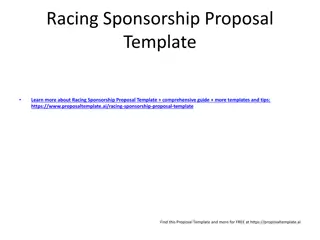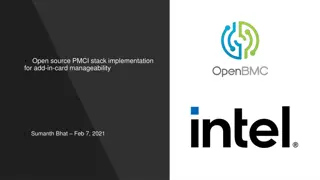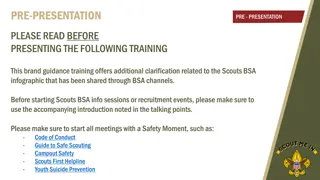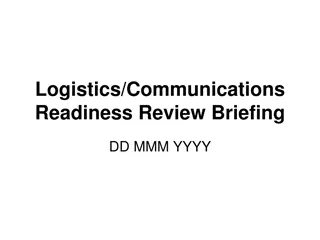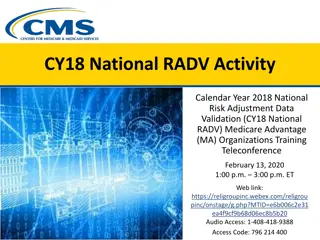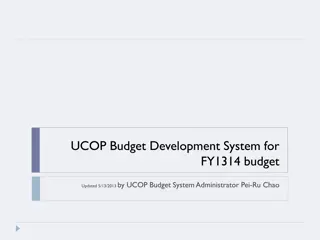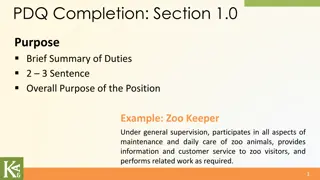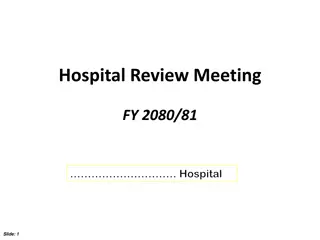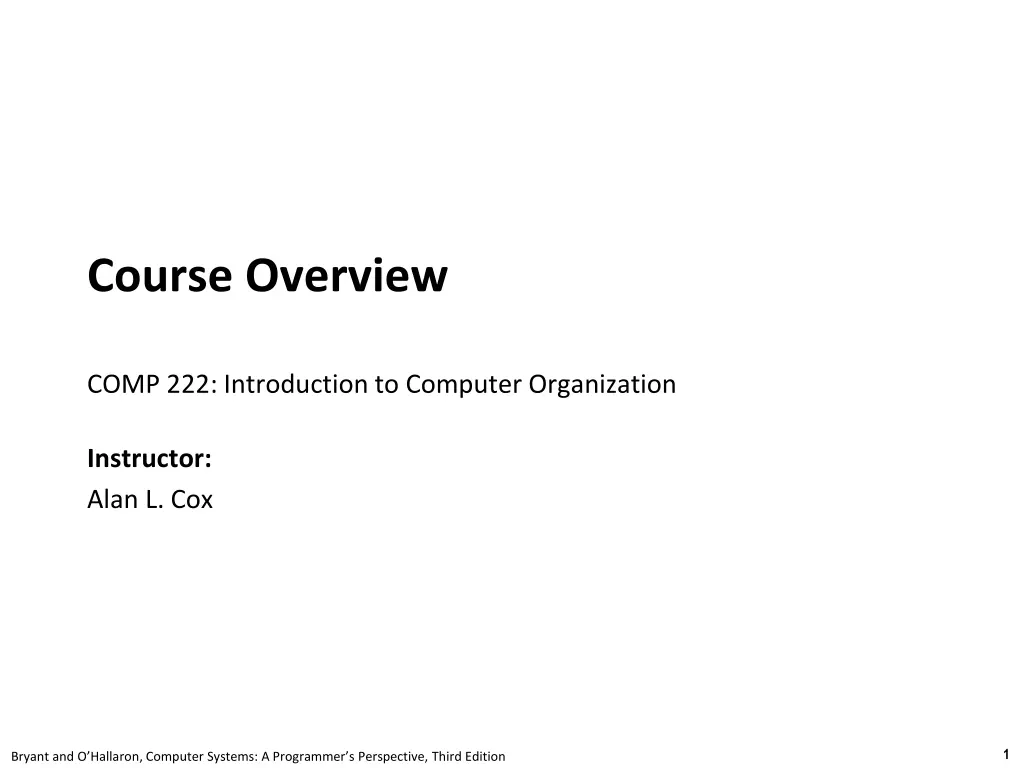
Computer Organization and Abstraction Realities at Carnegie Mellon
Explore how Carnegie Mellon's COMP 222 course delves into computer organization, emphasizing the importance of understanding underlying implementations despite abstractions. Topics covered include computer arithmetic, the distinction between integers and floats, and the implications for programming efficiency and bug elimination. Gain insights on the practical applications of abstraction in various contexts and prepare for advanced systems classes in computer science and electrical engineering.
Download Presentation

Please find below an Image/Link to download the presentation.
The content on the website is provided AS IS for your information and personal use only. It may not be sold, licensed, or shared on other websites without obtaining consent from the author. If you encounter any issues during the download, it is possible that the publisher has removed the file from their server.
You are allowed to download the files provided on this website for personal or commercial use, subject to the condition that they are used lawfully. All files are the property of their respective owners.
The content on the website is provided AS IS for your information and personal use only. It may not be sold, licensed, or shared on other websites without obtaining consent from the author.
E N D
Presentation Transcript
Carnegie Mellon Course Overview COMP 222: Introduction to Computer Organization Instructor: Alan L. Cox 1 Bryant and O Hallaron, Computer Systems: A Programmer s Perspective, Third Edition
Carnegie Mellon Overview Course theme Four realities How the course fits into the COMP curriculum Topics Logistics Policies 2 Bryant and O Hallaron, Computer Systems: A Programmer s Perspective, Third Edition
Carnegie Mellon Course Theme: Abstraction Is Good But Don t Forget Reality Most COMP courses emphasize abstraction Object-oriented design Asymptotic analysis These abstractions have limits Especially in the presence of bugs Need to understand details of underlying implementations Useful outcomes from taking COMP 222 (and 321) Become more effective programmers Able to find and eliminate bugs efficiently Able to understand and tune for program performance Prepare for later systems classes in COMP & ELEC Compilers, Operating Systems, Networking, Computer Architecture, Security, etc. 3 Bryant and O Hallaron, Computer Systems: A Programmer s Perspective, Third Edition
Carnegie Mellon Great Reality #1: Ints are not Integers, Floats are not Reals Example 1: Is x2 0? Floats: Yes! Ints: 40000 * 40000 1600000000 50000 * 50000 ?? Example 2: Is (x + y) + z = x + (y + z)? Unsigned & Signed Ints: Yes! Floats: (1e20 + -1e20) + 3.14 --> 3.14 1e20 + (-1e20 + 3.14) --> ?? Source: xkcd.com/571 4 Bryant and O Hallaron, Computer Systems: A Programmer s Perspective, Third Edition
Carnegie Mellon Computer Arithmetic Does not generate random values Arithmetic operations have important mathematical properties Cannot assume all usual mathematical properties Due to finiteness of representations Integer operations satisfy ring properties Commutativity, associativity, distributivity Floating point operations satisfy ordering properties Monotonicity, values of signs Observation Need to understand which abstractions apply in which contexts Important issues for compiler writers and serious application programmers 5 Bryant and O Hallaron, Computer Systems: A Programmer s Perspective, Third Edition
Carnegie Mellon Great Reality #2: You ve Got to Know Assembly Chances are, you ll never write programs in assembly Compilers are much better & more patient than you are But: Understanding assembly is key to machine-level execution model Behavior of programs in presence of bugs High-level language models break down Tuning program performance Understand optimizations done / not done by the compiler Understanding sources of program inefficiency Implementing system software Compiler has machine code as target Operating systems must manage process state Creating / fighting malware x86 assembly is the language of choice! 6 Bryant and O Hallaron, Computer Systems: A Programmer s Perspective, Third Edition
Carnegie Mellon Great Reality #3: Memory Matters Random Access Memory Is an Unphysical Abstraction Memory is not unbounded It must be allocated and managed Many applications are memory dominated Memory referencing bugs especially pernicious Effects are distant in both time and space Memory performance is not uniform Cache effects can greatly affect program performance Adapting program to characteristics of memory system can lead to major speed improvements 7 Bryant and O Hallaron, Computer Systems: A Programmer s Perspective, Third Edition
Carnegie Mellon Memory Referencing Bug Example typedef struct { int a[2]; double d; } struct_t; double fun(int i) { volatile struct_t s; s.d = 3.14; s.a[i] = 1073741824; /* Possibly out of bounds */ return s.d; } fun(0) fun(1) fun(2) fun(3) fun(4) fun(6) 3.14 3.14 3.1399998664856 2.00000061035156 3.14 Segmentation fault Result is system specific 8 Bryant and O Hallaron, Computer Systems: A Programmer s Perspective, Third Edition
Carnegie Mellon Memory Referencing Bug Example fun(0) fun(1) fun(2) fun(3) fun(4) fun(6) typedef struct { int a[2]; double d; } struct_t; 3.14 3.14 3.1399998664856 2.00000061035156 3.14 Segmentation fault Explanation: Critical State 6 ? 5 ? 4 Location accessed by fun(i) d7 ... d4 3 d3 ... d0 2 struct_t a[1] 1 a[0] 0 9 Bryant and O Hallaron, Computer Systems: A Programmer s Perspective, Third Edition
Carnegie Mellon Memory Referencing Errors C does not provide any memory protection Out of bounds array references Invalid pointer values Abuses of malloc/free Can lead to nasty bugs Whether or not bug has any effect depends on system and compiler Action at a distance Corrupted object logically unrelated to one being accessed Effect of bug may be first observed long after it is generated How can I deal with this? Program in Python, Java, Go, Rust, Understand what possible interactions may occur Use or develop tools to detect referencing errors (e.g., Valgrind) 10 Bryant and O Hallaron, Computer Systems: A Programmer s Perspective, Third Edition
Carnegie Mellon Great Reality #4: There s more to performance than asymptotic complexity Constant factors matter too! And even exact op count does not predict performance Easily see 10:1 performance range depending on how code written Must optimize at multiple levels: algorithm, data representations, procedures, and loops Must understand system to optimize performance How programs compiled and executed How to measure program performance and identify bottlenecks How to improve performance without destroying code modularity and generality 11 Bryant and O Hallaron, Computer Systems: A Programmer s Perspective, Third Edition
Carnegie Mellon Memory System Performance Example void copyij(int src[2048][2048], int dst[2048][2048]) { int i,j; for (i = 0; i < 2048; i++) for (j = 0; j < 2048; j++) dst[i][j] = src[i][j]; } void copyji(int src[2048][2048], int dst[2048][2048]) { int i,j; for (j = 0; j < 2048; j++) for (i = 0; i < 2048; i++) dst[i][j] = src[i][j]; } 81.8ms 4.3ms2.0 GHz Intel Core i7 Haswell Hierarchical memory organization Performance depends on access patterns Including how step through multi-dimensional array 12 Bryant and O Hallaron, Computer Systems: A Programmer s Perspective, Third Edition
Why The Performance Differs copyij 16000 14000 Read throughput (MB/s) 12000 10000 8000 6000 4000 2000 copyji 0 32k s1 128k s3 512k s5 2m s7 8m Stride (x8 bytes) s9 Size (bytes) 32m s11 128m 13 Bryant and O Hallaron, Computer Systems: A Programmer s Perspective, Third Edition
Carnegie Mellon Course Perspective Most 400-level systems courses are Builder-Centric Computer Architecture Design a pipelined processor Operating Systems Implement parts of an operating system Compilers Write a compiler for a simple language Networking Implement and simulate network protocols 14 Bryant and O Hallaron, Computer Systems: A Programmer s Perspective, Third Edition
Carnegie Mellon Course Perspective (Cont.) COMP 222 and 321 are Programmer-Centric Purpose is to show that by knowing more about the underlying system, one can be more effective as a programmer Enable you to Write programs that are more reliable and efficient Incorporate features that require hooks into operating system Are not just courses for dedicated hackers! Cover some material in these courses that you won t see elsewhere 15 Bryant and O Hallaron, Computer Systems: A Programmer s Perspective, Third Edition
Carnegie Mellon COMP 222 versus 321 Computer systems are designed and constructed in a layered fashion Each successively higher layer providing an abstract machine with greater capabilities Hardware/software interface (COMP 222) Basic hardware organization of computer systems Assembly/machine language How low-level software manipulates hardware state Operating system/application interface (COMP 321) Abstract hardware/software organization Higher-level languages How to use operating system services to access system resources 16 Bryant and O Hallaron, Computer Systems: A Programmer s Perspective, Third Edition
Carnegie Mellon COMP 222's Primary Goal That you gain an understanding of how a computer system executes your programs While this requires an understanding of assembly language, it rarely requires writing assembly language Mainly, you will program in C Why C? Its features can be implemented in a straightforward manner on modern processors It exposes the details of memory allocation and management to the programmer 17 Bryant and O Hallaron, Computer Systems: A Programmer s Perspective, Third Edition
Carnegie Mellon Textbooks Required: Randal E. Bryant and David R. O Hallaron, Computer Systems: A Programmer s Perspective, Third Edition (CS:APP3e), Pearson, 2016 http://csapp.cs.cmu.edu This book really matters for the course! How to solve labs Practice problems typical of exam problems Suggested: David Griffiths and Dawn Griffiths, Head First C, O'Reilly Media, 2012 An accessible yet comprehensive introduction to C 18 Bryant and O Hallaron, Computer Systems: A Programmer s Perspective, Third Edition
Carnegie Mellon Course Components Lectures Higher level concepts Ungraded ``practice'' labs Applied concepts, important tools and skills for graded labs Programming exercises Graded labs (``assignments'') The heart of the course 2-3 weeks each Provide in-depth understanding of an aspect of computer systems Programming and measurement Exams (midterm + final) Test your understanding of concepts 19 Bryant and O Hallaron, Computer Systems: A Programmer s Perspective, Third Edition
Carnegie Mellon Resources Class Web page: http://www.clear.rice.edu/comp222 Complete schedule of lectures, labs, and exams Copies of lectures and labs Contact information for the course staff Office hours Piazza General Q&A about lectures and labs Canvas Recording grades Time-critical announcements 20 Bryant and O Hallaron, Computer Systems: A Programmer s Perspective, Third Edition
Carnegie Mellon Primitive Data Types Topics Machine-level representation of characters, integers, and floating-point numbers Bit-wise operations, logical operations, arithmetic Graded Lab Data Lab: Manipulating bits, integers, and floating-point numbers 21 Bryant and O Hallaron, Computer Systems: A Programmer s Perspective, Third Edition
Carnegie Mellon Aggregate Data Types Topics Machine-level representation of arrays, strings, pointers, and structs Dynamic memory allocation Graded lab Count Lab: Using pointers to construct linked lists 22 Bryant and O Hallaron, Computer Systems: A Programmer s Perspective, Third Edition
Carnegie Mellon Programs Topics Assembly language programs Machine-level representation of control structures Layout of code and data within the memory of an executing program Graded Labs Bomb Lab: Defusing a binary bomb Attack Lab: The basics of code injection attacks 23 Bryant and O Hallaron, Computer Systems: A Programmer s Perspective, Third Edition
Carnegie Mellon Linking Topics Incremental compilation Combining multiple files to create a single program Libraries Graded Lab Linking Lab: Decoding Java class files Reinforces machine-level representation of data and dynamic memory allocation Also illustrates that the concepts taught are not C specific 24 Bryant and O Hallaron, Computer Systems: A Programmer s Perspective, Third Edition
Carnegie Mellon The Memory Hierarchy Topics Memory technology, memory hierarchy, caches, disks, locality Includes aspects of architecture and operating system Graded Lab Cache Lab: Building a cache simulator and optimizing for locality Learn how to exploit locality in your programs! 25 Bryant and O Hallaron, Computer Systems: A Programmer s Perspective, Third Edition
Carnegie Mellon Processor Architecture Topics Instruction Set Architecture (ISA) Logic design Staged execution of instructions Pipelining to accelerate execution 26 Bryant and O Hallaron, Computer Systems: A Programmer s Perspective, Third Edition
Carnegie Mellon Grades Exams (40%): mid-term (16%), final (24%) Mid-term: in-person, 7:00-9:00 PM, Monday, 10/21 You must inform me of any scheduling conflict by 10/7 Final: in-person, TBA Graded labs (60%): six, each 10% Final grades based on a curve Ungraded ``practice'' labs: extra credit for timely completion See the first lab for details 27 Bryant and O Hallaron, Computer Systems: A Programmer s Perspective, Third Edition
Carnegie Mellon Lab Policies Carefully read the Assignments web page Honor code policy Late policy Regrade policy All graded labs will be posted on the Assignments web page Graded labs are due at 11:55 PM on the due date, unless otherwise specified Graded labs must be done on the CLEAR servers running RHEL 9.X: ssh.clear9.rice.edu See the first ungraded ``practice'' lab for details Other systems may behave differently 28 Bryant and O Hallaron, Computer Systems: A Programmer s Perspective, Third Edition

![❤[READ]❤ Deep Space Craft: An Overview of Interplanetary Flight (Springer Praxis](/thumb/21511/read-deep-space-craft-an-overview-of-interplanetary-flight-springer-praxis.jpg)



